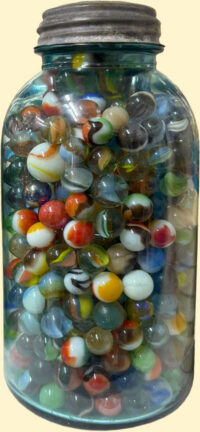
Many people find jars of old marbles and wonder if they’re valuable. The first step in knowing what you have is understanding whether the items are vintage or modern. The difference often lies in subtle details such as seams, glass type, color patterns, and signs of handcrafting.
The Quick Tests (Simple Visual Clues)
- Pontil vs. Seam: Handmades have pontil marks from being cut off a glass rod. Machine-mades have seams from molds.
- Glass Clarity: Vintage glass often has small bubbles or waves; modern marbles are smoother and clearer.
- Color and Pattern: Early marbles use oxblood reds, opaque swirls, or translucent layers — modern ones are often brighter or overly uniform.
- Weight and Feel: Older glass can feel denser or slightly textured compared to the slicker surface of new glass.
Identifying Handmade Marbles
- Pontil Marks: (Single or Double): Each handmade marble was formed at the end of a glass rod and detached while molten, leaving one or two pontil marks which are small rough spots or circular scars that confirm it was hand finished.
- Types: Common handmade varieties include German onionskins, Joseph’s Coats, micas, and sulphides. Each was created by layering or embedding molten glass using traditional techniques.
- Shape and Symmetry: Handmade marbles are rarely perfect spheres. Subtle irregularities in roundness or line spacing are natural and expected.
- Glass Texture and Bubbles: Many handmade marbles show tiny air bubbles, faint ripples, or layered glass that gives them depth and character not found in factory marbles.
- Color and Craftsmanship: Colors were applied by hand, often in multiple layers, creating intricate swirls, feathering, or ribbons. Onionskins, for example, show delicate outer color veils over a clear base.
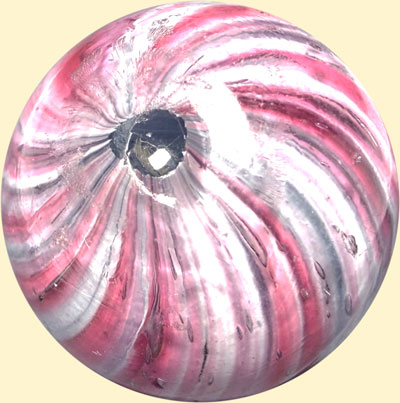
Handmade German Marble
Identifying Early Machine-Made Marbles
- Distinct Seams: Early machine-made marbles show one or two faint seam lines running from pole to pole where the molten glass mold joined together. These seams are the quickest way to confirm factory production.
- Color Layering: Makers such as Akro Agate, Peltier, Christensen, and Vitro created unique color blends by feeding separate glass streams into the machines. The result is layered ribbons, corkscrews, and rainbos with rich depth and contrast.
- Pattern Signatures: Akro Agate is best known for its corkscrew twists, Peltier for its National Line Rainbos and Christensen for its vivid flame swirls. Each company’s signature patterns helps identify the maker.
- Surface Quality: Early machine-made marbles are smooth and glossy but may show small shear marks or cold-roll lines from cooling. These details add authenticity and distinguish them from modern reproductions.
- Color and Clarity: Older marbles often display slightly muted tones or subtle transparency changes caused by early glass formulas. Unlike modern marbles, these shifts in color are part of their charm and collectible appeal.
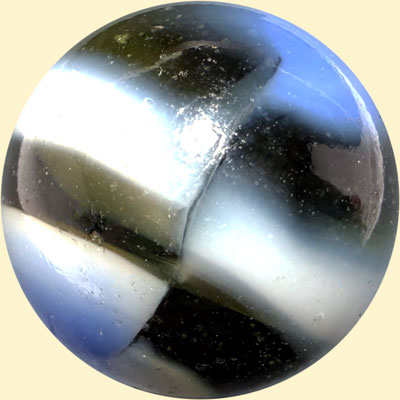
Machine-Made Marble
Common Modern or Toy Marbles
- Uniform glass without layers
- Bright, even colors
- Smooth and perfect spheres
- Often made by companies like Vacor or Mega Marbles in Mexico or China
- Typically lack bubbles or evidence of handwork
- Often sold in mesh bags or as decorative filler
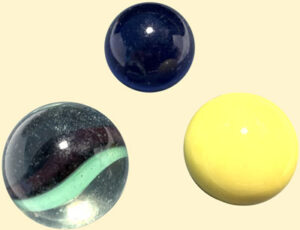
Mass-Produced Marbles
More Advanced Tips for Identifying What You Have
Look for Iridescence
Some marbles show a rainbow or oil-slick effect on the surface. This “iridescence” can be natural from age and weathering or applied during production. For example:
- Naturally aged iridescence on dug marbles or those buried in the ground over time.
- Factory iridescence was sometimes applied intentionally in later years.
Tip: Use a flashlight to highlight the surface at different angles. A subtle iridescent glow may point to older or rare production.
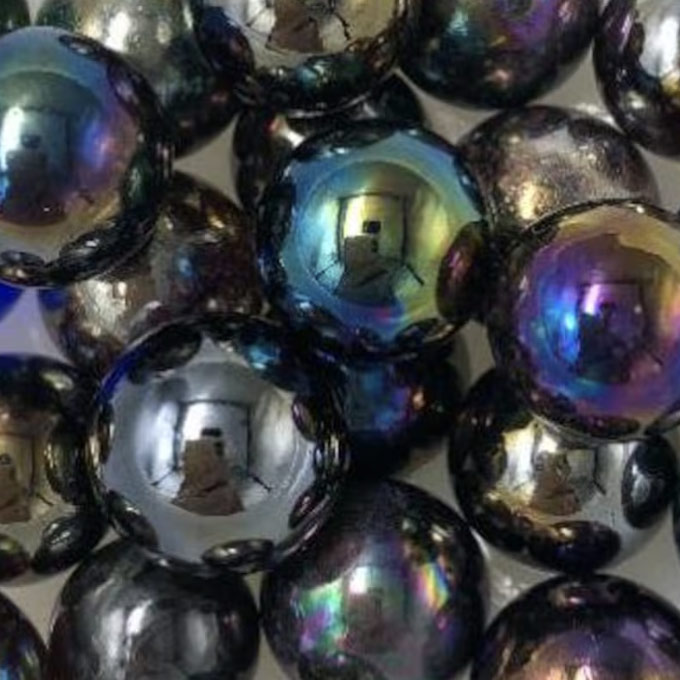
Iridescent Marbles

Try the Blacklight Test
Many older marbles fluoresce under a $10 UV blacklight due to the presence of manganese or other compounds. This can help confirm the marble’s age:
- Akro Agate and Christensen Agate Co. marbles often glow under blacklight.
- Modern glass typically does not unless treated.
A UV flashlight is an affordable tool that helps distinguish vintage from modern at a glance.
Watch for Foreign-Made Marbles
Not all valuable marbles were made in the U.S. or Germany. Some collectible varieties come from:
- Japanese cat’s eyes from the 1950s–60s
- European swirls and “slag” types from France, Belgium, or the UK
- Mexican Vacor variants including custom blends
- Chinese machine-mades from the 1990s onward
Note: Modern imports can sometimes mimic vintage designs but lack the depth, layering, and weight.
Assessing Damage
Condition plays a huge role in value. Marbles with chips, surface wear, or cracks often have diminished value even if they’re old. Use a 10x magnifier to check for:
- Moon spots (small dings)
- Flea bites (tiny nicks)
- Surface clouding or wear from play
High-grade marbles should be near mint with original wet surface intact and no visible glass loss.
The “One-of-a-Kind” Test
If you can’t find anything similar online or in guides, it may be:
- A rare variety
- A transitional marble
- A “garage glass” or studio art piece
Art marbles from contemporary artists like Kevin Leidich, Rick Satava, or Josh Simpson may resemble vintage types but are often signed and carry different value tiers.
When in Doubt, Get a Second Opinion
It can be tough to confidently assess a marble’s age, type, and value. If you’re unsure:
- Take clear, well-lit photos with a white or light towel as background
- Include top and side views
- Submit to a trusted appraisal site like MarbleBuyer.com
- Consult collector forums like MarbleConnection or Facebook groups
My Final Thoughts
Learning to tell vintage from modern marbles takes time, patience, and a trained eye. The more marbles you handle and study, the better your instincts will become.
Take notes on the ones you find, photograph them in natural light, and start categorizing by type, size, and characteristics. You may uncover a real gem, or simply gain a deeper appreciation for these tiny works of glass art.
Bonus Tip: When in Doubt, Photograph
If you’re unsure, upload photos for a free appraisal. I can usually tell at a glance whether your marbles are vintage, handmade, or modern toy types.


